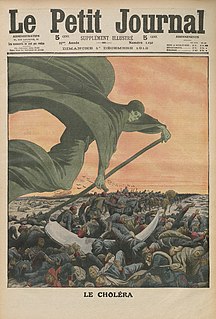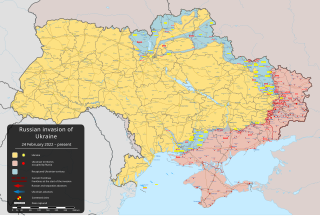
Cholera is an infection of the small intestine by some strains of the bacterium Vibrio cholerae. Symptoms may range from none, to mild, to severe. The classic symptom is large amounts of watery diarrhea that lasts a few days. Vomiting and muscle cramps may also occur. Diarrhea can be so severe that it leads within hours to severe dehydration and electrolyte imbalance. This may result in sunken eyes, cold skin, decreased skin elasticity, and wrinkling of the hands and feet. Dehydration can cause the skin to turn bluish. Symptoms start two hours to five days after exposure.

The Donetsk Oblast, also referred to as Donechchyna, is an oblast of eastern Ukraine. It is Ukraine's most populous oblast, with around 4.1 million residents. Its administrative centre is Donetsk; however, its Regional State Administration has been temporarily relocated to Kramatorsk because of the ongoing Russo-Ukrainian war. Historically, the region has been an important part of the Donbas region. Until November 1961, it bore the name Stalino Oblast as Donetsk was then named "Stalino", in honour of Joseph Stalin. As part of the de-Stalinization process, it was renamed as its administrative centre after Siversky Donets, the main artery of Eastern Ukraine. Its population is estimated as 4,100,280

Mariupol is a city on the north coast of the Sea of Azov at the mouth of the Kalmius river, in the Pryazovia region. While internationally recognized as in Ukraine, the city is under the de facto administration of the Donetsk People's Republic.

The first cholera pandemic (1817–1824), also known as the first Asiatic cholera pandemic or Asiatic cholera, began near the city of Calcutta and spread throughout South and Southeast Asia to the Middle East, eastern Africa and the Mediterranean coast. While cholera had spread across India many times previously, this outbreak went further; it reached as far as China and the Mediterranean Sea before subsiding. Millions of people died as a result of this pandemic, including many British soldiers, which attracted European attention. This was the first of several cholera pandemics to sweep through Asia and Europe during the 19th and 20th centuries. This first pandemic spread over an unprecedented range of territory, affecting almost every country in Asia.

The second cholera pandemic (1826–1837), also known as the Asiatic cholera pandemic, was a cholera pandemic that reached from India across western Asia to Europe, Great Britain, and the Americas, as well as east to China and Japan. Cholera caused more deaths, more quickly, than any other epidemic disease in the 19th century. The medical community now believes cholera to be exclusively a human disease, spread through many means of travel during the time, and transmitted through warm fecal-contaminated river waters and contaminated foods. During the second pandemic, the scientific community varied in its beliefs about the causes of cholera.
The fourth cholera pandemic of the 19th century began in the Ganges Delta of the Bengal region and traveled with Muslim pilgrims to Mecca. In its first year, the epidemic claimed 30,000 of 90,000 pilgrims. Cholera spread throughout the Middle East and was carried to Russia, Europe, Africa and North America, in each case spreading via travelers from port cities and along inland waterways.

The sixth cholera pandemic (1899–1923) was a major outbreak of cholera beginning in India, where it killed more than 800,000 people, and spreading to the Middle East, North Africa, Eastern Europe and Russia.

The 2008 Zimbabwean cholera outbreak was an epidemic of cholera affecting much of Zimbabwe from August 2008 until June 2009. The outbreak began in Chitungwiza in Mashonaland East Province in August 2008, then spread throughout the country so that by December 2008, cases were being reported in all 10 provinces. In December 2008, The Zimbabwean government declared the outbreak a national emergency and requested international aid. The outbreak peaked in January 2009 with 8,500 cases reported per week. Cholera cases from this outbreak were also reported in neighboring countries South Africa, Malawi, Botswana, Mozambique, and Zambia. With the help of international agencies, the outbreak was controlled, and by July 2009, after no cases had been reported for several weeks, the Zimbabwe Ministry of Health and Child Welfare declared the outbreak over. In total, 98,596 cases of cholera and 4,369 deaths were reported, making this the largest outbreak of cholera ever recorded in Zimbabwe. The large scale and severity of the outbreak has been attributed to poor sanitation, limited access to healthcare, and insufficient healthcare infrastructure throughout Zimbabwe.
The 2009 flu pandemic was a global outbreak of a new strain of influenza A virus subtype H1N1, first identified in April 2009, termed Pandemic H1N1/09 virus by the World Health Organization (WHO) and colloquially called swine flu. The outbreak was first observed in Mexico, and quickly spread globally. On the 11th of June 2009, the WHO declared the outbreak to be a pandemic. The overwhelming majority of patients experience mild symptoms, but some persons are at higher risk of suffering more serious effects; such as those with asthma, diabetes, obesity, heart disease, or those who are pregnant or have a weakened immune system. In the rare severe cases, around 3–5 days after symptoms manifest, the sufferer's condition declines quickly, often to the point respiratory failure. Although Ukraine was not (very) affected at first there was on outbreak of the virus in Western Ukraine in early November 2009 that led to the closing of public buildings and cancellation of meetings for three weeks.

Seven cholera pandemics have occurred in the past 200 years, with the first pandemic originating in India in 1817. The seventh cholera pandemic is officially a current pandemic and has been ongoing since 1961, according to a World Health Organization factsheet in March 2022. Additionally, there have been many documented major local cholera outbreaks, such as a 1991–1994 outbreak in South America and, more recently, the 2016–2021 Yemen cholera outbreak.

Diseases and epidemics of the 19th century included long-standing epidemic threats such as smallpox, typhus, yellow fever, and scarlet fever. In addition, cholera emerged as an epidemic threat and spread worldwide in six pandemics in the nineteenth century. The third plague pandemic emerged in China in the mid-nineteenth century and spread worldwide in the 1890s.

The COVID-19 pandemic in Ukraine has resulted in 5,040,518 confirmed cases of COVID-19 and 112,459 deaths.

The COVID-19 vaccination campaign in Ukraine is an ongoing mass immunization campaign for the COVID-19 pandemic in Ukraine.
Events in the year 2022 in Ukraine.

On 24 February 2022, Russia invaded Ukraine in a major escalation of the Russo-Ukrainian War that began in 2014. The invasion caused Europe's largest refugee crisis since World War II, with more than 8.8 million Ukrainians fleeing the country and a third of the population displaced. The invasion also caused global food shortages.

On 24 February 2022, Russia launched a military invasion of Ukraine. This timeline is a dynamic and fluid list, and as such may never satisfy criteria of completeness. Please note that some events may only be fully understood and/or discovered in retrospect.

The southern Ukraine offensive is an ongoing theatre of operation in the 2022 Russian invasion of Ukraine. From their base in Russian-occupied Crimea, Russian armed forces attacked Kherson Oblast, Mykolaiv Oblast, and Zaporizhzhia Oblast in southern Ukraine. On 24 February, Russian forces engaged the Armed Forces of Ukraine.

The siege of Mariupol was a siege in Ukraine during the 2022 Russian invasion of Ukraine, when forces from Russia and the separatist Donetsk People's Republic engaged Ukrainian forces in the city of Mariupol. The battle, which was part of the Russian eastern Ukraine offensive and southern Ukraine offensive, started on 24 February 2022 and concluded on 20 May 2022, when Russia announced the remaining Ukrainian forces in Mariupol surrendered after they were ordered to cease fighting.

The eastern Ukraine offensive is an ongoing theatre of operation in the 2022 Russian invasion of Ukraine in the three provinces (oblasts) of eastern Ukraine: Donetsk Oblast and Luhansk Oblast and Kharkiv Oblast. The invasion is an escalation or intensification of the Russo-Ukrainian War, which had been waged between Ukraine and pro-Russian separatists since 2014.
Hero City of Ukraine is a Ukrainian honorary title awarded for outstanding heroism during the 2022 Russian invasion of Ukraine. It was awarded to ten cities in March 2022, in addition to four already named Hero City by the Soviet Union. This symbolic distinction for a city corresponds to the individual distinction of Hero of Ukraine.















